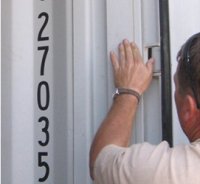Checking used freight containers for safety and seaworthiness
When buying used freight containers, you need to make sure those containers are in fine, or at least, acceptable conditions. Here’s how to do…
As a specialist buyer or if you can afford, hiring surveyors to do inspection seems a good solution. Some professional organizations, like IICL (The Institute of International Container Lessors) in the USA, are be able to assist you. You can find a list of certified container inspectorson the IICL website.
In case you want to do it yourself, you need to focus on important points that I will mention below.
First, you should check to make sure containers’ structure is not damaged. While containers are designed in modular with very strong structure, it doesn’t mean the used products still keep the same characteristics after in use for years. This can be done visually by asking dealers to send you some high quality photos of the inside, outside and top ... all 4 sides, inside and out.

Secondly, while most of all containers are manufactured in accordance with ISO standards, but there still exist non-standard units in operation. You surely want to buy the traditional boxes with standardized dimensions, so that they can connect properly to other units in your project. So, ask the seller and check whether those used freight containers have registration symbols, which are signal of standardization.
While it’s hard to fulfill technical checking in detail, you as a buyer should check crucial points in person, to make sure those units are in acceptable conditions. Regarding this aspect, midweststoragecontainers.com suggests a useful tips for amateur buyers to exam used freight containers.
- Check to make sure the container is wind and water tight. Shut yourself in the container and look for daylight. Inspect any rust areas to make sure it is only surface rust. Containers will accumulate surface rust long before a hole is formed;
- Look to make sure the doors open and close correctly and completely. Look for intact door seals and sturdy floors with no soft spots. Examine any inserts (repairs of holes are welded on the outside and caulked on the inside); they should be properly installed and repainted;
- Look for corrosion and rust under door seals and hardware;
- Check for major dents in the sides or the roof; there should be none;
- Make sure there is no evidence of contamination or foul odors(e.g., hides can be transported in containers, leaving a strong odor).
If above deficiencies are detected, you might consider asking for proper repair, deducting the price, or simply refuse the unit. That depends on your purpose of use. For whatever purpose, careful inspection enables you to know actual conditions. Then, buying or not is your call.
Above I talk about inspection of used dry containers. You may want to learn more about sources of used containers or how to buy used containers. Just click the relevant links and you’ll get the answers.
Move from Checking used freight containers to Containers sale
New! Comments
Have your say about what you just read! Leave me a comment in the box below.